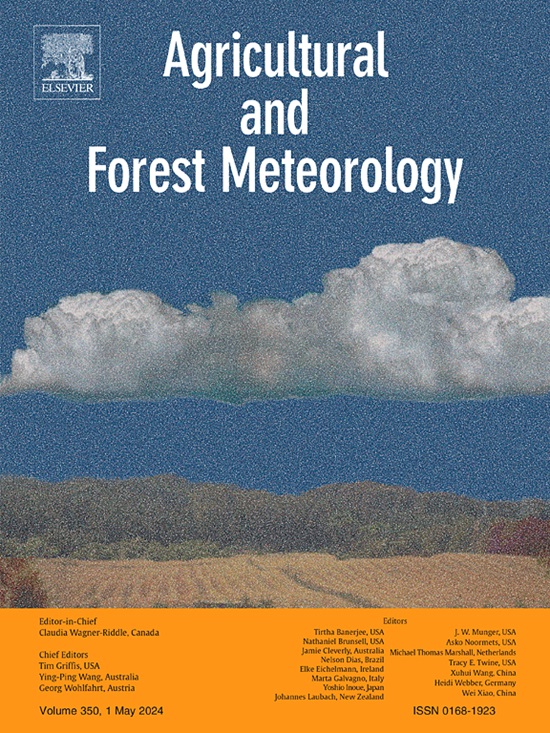Modeling carbon and water fluxes in agro-pastoral systems under contrasting climates and different management practices
IF 5.6
1区 农林科学
Q1 AGRONOMY
引用次数: 0
Abstract
Grasslands are worldwide spread ecosystems involved in the provision of multiple functional services, including biomass production and carbon storage. However, the increasingly adverse climate and non-optimised farm management are threatening these ecosystems. In this study, the original semi-mechanistic remotely sensed-driven VISTOCK model, which simulates grass growth as limited by thermal and water stress, was modified and integrated with the RothC model to simulate the ecosystem fluxes. The new model (GRASSVISTOCK) showed satisfactory performance in simulating above-ground biomass (AGB) in dry matter (d.m.) and fractional transpirable soil water (FTSW) along Alps (AGB, RMSE = 85.39 g d.m. m−2; FTSW, RMSE = 0.21) and Mediterranean (AGB, RMSE = 136.84 g d.m. m−2; FTSW, RMSE = 0.13) grasslands. Also, GRASSVISTOCK was able to simulate the net ecosystem exchange (NEE - RMSE = 0.03 Mg C ha−1), the gross primary production (RMSE = 0.04 Mg C ha−1), the ecosystem respiration (RMSE = 0.04 Mg C ha−1) and the evapotranspiration (RMSE = 1.44 mm), where these observations were available (Alps). The model was applied under present and two climate datasets characterised by temperature increase and precipitation decrease (+2 °C temperature, -10 % precipitation) and reference or enriched CO2 concentration (394 vs. 540.5 ppm) scenarios. The results showed that, while changes in temperature and precipitation alone had a negative impact by increasing NEE (+0.69 Mg C ha−1) and decreasing total biomass (-0.20 Mg d.m. ha−1) in the reference CO2 scenario, the enriched atmospheric CO2 concentration partially smoothed the NEE trend (+0.27 Mg C ha−1) and increased total biomass (+0.60 Mg d.m. ha−1) compared to the present period. It is concluded that the GRASSVISTOCK model represents a first step towards an integrated tool for estimating the performance of the agro-pastoral systems in terms of biomass production, water and carbon fluxes, in the face of ongoing climate change.
在不同气候和不同管理做法下,模拟农牧系统的碳和水通量
草原是分布在世界各地的生态系统,提供多种功能服务,包括生物质生产和碳储存。然而,日益不利的气候和不优化的农场管理正在威胁着这些生态系统。在本研究中,对原始的半机械遥感驱动的VISTOCK模型进行了改进,并将其与RothC模型相结合,以模拟受热胁迫和水分胁迫限制的草地生长。新模型(GRASSVISTOCK)在模拟阿尔卑斯山脉沿线干物质(d.m.)地上生物量(AGB)和土壤分份可蒸腾水分(FTSW) (AGB, RMSE = 85.39 g d.m m−2)方面表现良好;FTSW, RMSE = 0.21)和地中海(AGB, RMSE = 136.84 g d.m.m−2;FTSW, RMSE = 0.13)。此外,GRASSVISTOCK能够模拟净生态系统交换(NEE - RMSE = 0.03 Mg C ha - 1),总初级生产力(RMSE = 0.04 Mg C ha - 1),生态系统呼吸(RMSE = 0.04 Mg C ha - 1)和蒸散(RMSE = 1.44 mm),这些观测值都是可用的(阿尔卑斯山)。该模型应用于当前和两个气候数据集,其特征是温度升高和降水减少(+2°C温度,- 10%降水)和参考或富集CO2浓度(394对540.5 ppm)情景。结果表明,在参考CO2情景下,温度和降水的单独变化会增加NEE (+0.69 Mg C ha−1)和减少总生物量(-0.20 Mg d.m. ha−1),但与当前相比,大气CO2浓度的增加部分平滑了NEE趋势(+0.27 Mg C ha−1)和增加总生物量(+0.60 Mg d.m. ha−1)。结论是,GRASSVISTOCK模型是朝着建立一个综合工具迈出的第一步,该工具可用于在面对持续气候变化的情况下,从生物量生产、水和碳通量方面估计农牧系统的性能。
本文章由计算机程序翻译,如有差异,请以英文原文为准。
求助全文
约1分钟内获得全文
求助全文
来源期刊
CiteScore
10.30
自引率
9.70%
发文量
415
审稿时长
69 days
期刊介绍:
Agricultural and Forest Meteorology is an international journal for the publication of original articles and reviews on the inter-relationship between meteorology, agriculture, forestry, and natural ecosystems. Emphasis is on basic and applied scientific research relevant to practical problems in the field of plant and soil sciences, ecology and biogeochemistry as affected by weather as well as climate variability and change. Theoretical models should be tested against experimental data. Articles must appeal to an international audience. Special issues devoted to single topics are also published.
Typical topics include canopy micrometeorology (e.g. canopy radiation transfer, turbulence near the ground, evapotranspiration, energy balance, fluxes of trace gases), micrometeorological instrumentation (e.g., sensors for trace gases, flux measurement instruments, radiation measurement techniques), aerobiology (e.g. the dispersion of pollen, spores, insects and pesticides), biometeorology (e.g. the effect of weather and climate on plant distribution, crop yield, water-use efficiency, and plant phenology), forest-fire/weather interactions, and feedbacks from vegetation to weather and the climate system.

 求助内容:
求助内容: 应助结果提醒方式:
应助结果提醒方式:


